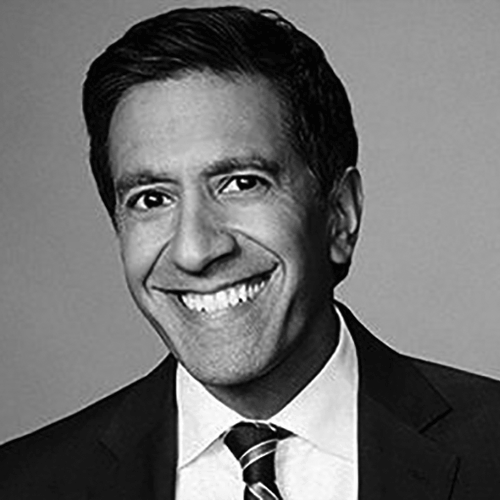
Peter Zeihan: Europe Goes Nuclear
We’ve got two major developments in Eurasia. We’re talking about Ukraine disabling two ships in the Caspian Sea and Poland getting EU approval to build…
Thought Leader: Peter Zeihan
In the past year, overlooked technologies — like telehealth — became critical to the delivery of quality healthcare. Our panel of experts weighed in on how the growing use of these technologies will impact the future of our healthcare system.

Neurosurgeon and Chief Medical Correspondent, CNN
In the world of telehealth, the doctor will always make a house call. That is, by mobile device or other technological means. Surely this is a way to improve the global health of the world. In developing countries with very little or no access to high quality medical care, but often access to a mobile device, it has the potential to change the health outcomes for people everywhere.
For developed countries, EMRs (electronic medical records) need to become standard operating procedure. Many problems with regards to safety can be traced to poor communication between internal hospital departments. These efficiencies can help patients become their own healthcare managers.
By hospitals offering “MyChart” types of online access, both doctor and patient keep track of what prescriptions are being ordered and exact usage of them. It can reduce errors and note adverse drug reactions, while offering savings gains when there are fewer medical errors. It also enables doctors across the spectrum to have the total scope of their patients’ full histories to make better diagnostic assessments.
Limited coverage for telehealth services is an obstacle for widespread adoption. As more technology is being introduced, it is not uncommon for software to have its kinks. We need to be certain that developers understand that in medicine we are in the zero-mistake business, and to make sure that it doesn’t hurt anyone. This raises accuracy and regulation of health apps.
Developers need to decide if they are creating a medical device or a wellness app. The FDA plays a role in the 510 (k) registration process, assessing the product on its safety and effectiveness. Additionally, hospitals are under intense financial pressures. When telemedicine comes along, it could save a patient from heading to an ER where expensive and sometimes unnecessary tests would be provided.
Medical providers are working with states to come up with their own infrastructures to deliver services. As a doctor, if I am not looking closely at you in person, we need guidelines to establish accountability to protect you. Many payers (insurance companies) are interested in moving forward with telehealth, which has rural roots, so some of these states tend to be further along.
There is no doubt that it’s coming, and fast. It will revolutionize the industry. It really shines in primary care. If you have an established relationship with your M.D. and they are available via MHealth, then continuity of care is a big win for you. Your doctor can continue to maintain a central archive of your medical records. It also means that if you live in a restricted or rural area, it can be a good option.
Currently, doctors are being marketed with various app opportunities and options to connect with patients far outside their geographical areas.
By definition, “tele-” is a prefix meaning “at a distance.” When you meet with your doctor in person, they are accountable for your medical care as part of an organized and licensed practice. When you break away from this model and potentially consult with several different practitioners, who then becomes accountable for your health?
Each state maintains a list of licensed physicians through the state medical board. You can check online to see if a doctor has a license to practice or has any claims against them.
The ATA (American Telemedicine Association) has an accreditation program, though not required, which shows consumers they are an established direct-to-consumer business, similar to the retail health model. Patients who choose to participate in telehealth should be aware of the risks. Look to see if someone is licensed or has a history of malpractice. Are you establishing a patient/Dr. relationship in terms of accountability? If the provider is in another state, holding them liable is more complicated.

CEO, RepuGen
The biggest impact we have seen among the 1,700+ RepuGen clients of its reputation management, patient satisfaction measurement, and patient engagement platform is the adoption of telemedicine.
Physicians were forced to use it due to the pandemic last year, and the majority of our clients are using telemedicine regularly even after in-office visits restarted. RepuGen started tracking the patient satisfaction of in-office and telemedicine healthcare consultations. The satisfaction level is the same for both, which bodes well for telemedicine.
RepuGen clients’ experience with older patients suggests that the satisfaction level is very high with the quality of medical care they received through telemedicine. They appear to appreciate the convenience of seeing their physicians without needing to visit a doctor’s office
We will see an increasing acceptance of telemedicine & nurse practitioners for regular healthcare services. Several customized medical treatments are expected due to the advancements of DNA testing, mRNA-based new medication, and the reduced cost of customized medical treatment.
We expect to see several mRNA-based treatments for cancer and other diseases.

Chief Medical Officer and Co-Founder, Wellview
Telehealth has been the primary driver for improving access to care over the past year. The pandemic forced quick adoption of telehealth with both patients and providers to accommodate physical distancing while also enabling the delivery of care.
In the past, telehealth was primarily driven by simple sick visits. Though this continued to be a trend, especially during the pandemic, we also saw an expansion of telehealth services for continuity of care and chronic disease management. Telehealth is a transformative way in which patients and providers can communicate and provide access to care.
I would be remiss to not mention telehealth not only expanded the physician/patient access to care, but spurred an explosion of telemental health, which is central to whole-person well-being. Additionally, at Wellview, we have also seen further uptake of telehealth visits with mental health experts, dietitians, physical therapists, clinical diabetes educators, and health coaches. This adoption is essential to provide easy access to high-value multidisciplinary care at a great price.
Remote patient monitoring (RPM) is the use of digital technologies to monitor and capture real-time health data from patients providing critical insight to providers. As providers, we must prioritize the use and integration of this data in the EHR. Tech-enabled RPM is key to providing convenient and high-value care right now, and even more so in the future.
We’re also seeing a positive impact of RPM on patient engagement and education in their own health. Patients become educated on parameters to monitor at home, which leads to further compliance, better outcomes, and a healthier lifestyle. Continuous glucose monitors (CGMs), as an example, allow a patient to check blood glucose comfortably, and also educates them on appropriate nutrition as the patient is able to see the fluctuations with certain types of foods in real-time.
RPM also increases continuity of care as providers are able to make recommendations on lifestyle changes and decisions around medications, or further therapeutic actions based on information from the devices, many times without the patient having to come for an in-person visit. Additional RPM devices that have been revolutionary in care include the pulse oximeter, blood pressure monitor, digital scales, mobile EKGs, medication reminders, and many others.
Telehealth expansion will continue to grow past episodic care and expand into chronic disease management and speciality care, including mental health services. For patients, this enables greater access and convenience to care. For the provider, it creates an opportunity to improve patient experience and allows for visits that can be appropriately performed without the need for a physical exam.
Telehealth will not upend the need for in-person exams, but will continue to enable better continuity for patients with PCPs and speciality providers. In tandem with telehealth, the use of wearable devices and remote monitoring will continue to expand, providing real-time, actionable data to providers, and helping to educate patients and enable more high-value care.
Additionally, the focus on holistic or whole-person care will grow over the next five years as patients become more informed and active in their health journeys. Telehealth will continue to play a pivotal role in opening the door to high-value, multidisciplinary care at a great price. This newfound access will increase the average patient’s use of an integrated care team, such as mental health experts, dietitians, physical therapists, clinical diabetes educators, and health coaches. In partnership with a PCP, this team approach will yield lasting outcomes by supporting the patient not only in medical care but also necessary lifestyle behavior changes.

General Manager of Healthcare and Life Sciences & Executive Medical Director, Salesforce
The pandemic necessitated, and therefore accelerated, a digital transformation that was already occurring in healthcare. Providers were forced to embrace virtual and digital solutions overnight to continue providing patients with the care they need. But what also happened is that as providers and patients began using these technologies, they found out they actually liked using these services.
These kinds of technologies allow for patients to access care services and for providers to see their patients more easily. This always-on capability is cost effective, reduces barriers for access, and provides patients with long-term health benefits. But we are just scratching the surface of what is possible.
It is absolutely virtual care, because it is the core of that always-on, digital-first approach I mentioned. That said, there is a misconception that virtual care just means video visits with a doctor. What people forget is that there is actually an entire ecosystem of technologies and services that deliver and enhance virtual care, including texting, call center functionality and patient educational services. Furthermore, prioritizing virtual care also means prioritizing the infrastructure needed to deliver virtual care, which is something we are keenly focused on at Salesforce.
We’ve opened Pandora’s box when it comes to virtual care, and there is no going back. In five years, you will see that healthcare is far more accessible from your home and your devices. Guaranteed, there will be more opportunities to virtually connect with your doctor and specialists, and easier ways for providers to monitor your health between appointments and outside of their office. As healthcare becomes easier to access, patients will become savvier about the choices available to them and the costs, and I would imagine that easier access to care will drive costs down.
Finally, the pandemic has put healthcare at the center of focus for every consumer and every company, and I think it will continue to be a core priority for the foreseeable future. It is a key priority for Salesforce and why you’ll continue to see us actively rolling out new innovations in the healthcare space.

Healthcare and Virtual Care Underwriter, Beazley
For healthcare professionals delivering the same services remotely as they did through “traditional” in-person healthcare, the risks associated with the care provision are virtually the same. Therefore, typical risks like improper care or prescribing of medications, misdiagnosis, or failure to intervene are all still present.
While the care provided is the same, it is the delivery method that has changed in a virtual environment, adding new elements of technology and cyber-related risk for providers to contend with. An organization that was traditionally a brick-and-mortar care practice that now also offers virtual care needs to be aware of its exposure to errors and omissions due to technology failure and cyber-related liability, in addition to their traditional, general, or professional liability exposures.
When medical consultations are delivered via video or phone rather than in the office, providers also need to be certain that patient confidentiality is maintained in both settings. A key consideration for health professionals is that the remoteness of these patient interactions can, by nature, make it very difficult to intervene in emergency situations, which means careful attention needs to be paid to knowing when the care needs to move from remote to an in-person environment.
Conversely, many tech businesses entering the digital healthcare space typically have more understanding of the technology and data risks, but do not always understand the added exposure and potential liability arising from physical injury that results from their customers using their technology.
An advantage of digital healthcare is the ability for providers to deliver specialist services to patients across state or even national borders, however, operating across multiple jurisdictions adds complexity and risk for providers to navigate.
Each U.S. state has its own set of rules and regulations regarding licensing and required limits of insurance; even the definition of telemedicine varies by state. Just because a provider is licensed in one state, they may not be legally permitted to provide the same care in any other state. While some states will honor out-of-state licenses, others will not, and sometimes licensing depends on the type of care being offered. This is nothing new and has always been an area of confusion for virtual care providers.
While the relaxation or removal of some regulations governing telehealth provisions by the federal government made it easier for patients to receive healthcare remotely since the start of the pandemic, these changes are temporary and could revert back to pre-pandemic guidelines at any time. The key takeaway here is that telehealth regulation is still in the early stages of development, and is likely to change rapidly in the coming months and years. It is critical that providers have risk management measures in place to help ensure they are able to keep up with regulatory changes and remain compliant.
The growth of this market has been staggering in recent years, and the COVID-19 pandemic has only accelerated this. Even within the rapidly growing digital health and wellness sector, mHealth and health technology businesses are among the most ambitious in terms of growth, with 73 percent and 59 percent, respectively, planning international expansion this year.
Wellness apps and wearable devices that track fitness, for example, are now ubiquitous in our lives. Since most of these apps do not include direct interaction with a healthcare provider, it can be easy to overlook the liability these businesses have for the potential bodily injury risk to users. But there are two key areas of risk that really stand out for mHealth businesses.
The first is data and privacy liability. These apps can often collect very sensitive and private healthcare information on potentially millions of users. Especially with the current rise in ransomware attacks globally, but also with cyber risk in general, these businesses should be proactive with implementing strong security measures to protect user data, particularly given that healthcare information is among the most valuable type of data to a cyber criminal.
The other area of concern is the efficacy of these apps and devices. Personal wellness apps in particular are enormously popular, but they are rarely, if ever, intended to replace traditional medical care or advice. It is important that app developers or providers are transparent about the intended uses and potential limitations of their products to mitigate their exposure to claims from users who may overly rely on their technology to monitor or treat ailments outside of the intended scope. Furthermore, healthcare providers that prescribe or recommend such technology should be confident in the efficacy and scope of the tech as well.

Co-Founder and CEO, MedSign International Corporation
I have seen the adoption of Telehealth technology as an enormous lifesaving service that enabled millions of Americans to receive quality healthcare during the pandemic crisis, which forced many, especially the elderly, to be confined and isolated. Telehealth has provided remote access to healthcare services, enabling those who are medically or socially vulnerable the ability to maintain continuity of care, avoiding negative consequences from delayed chronic or routine care due to limited or no access to in-office visits with their medical professionals.
Healthcare providers are already investing in emerging technologies like virtual care services that use artificial intelligence to digitally transform their industry. However, for these new technologies to be truly effective, there should be a national initiative, led by a collaboration of government and corporate health and non-health industry leadership. The focus must be on advancing state-of-the-art technologies, such as remote patient monitoring, so that everyone, especially the most vulnerable populations, have equal access and opportunity to quality healthcare services.
I would like to say yes, but no, most of the telehealth platforms are challenging for the senior demographic. There are more than 260 telehealth companies that use computers and smartphones as the communication portal to healthcare providers, yet these same systems are too complex for the elderly, most of whom are technology averse. Therefore, many of our older generation do not access telehealth services. With a majority of Medicare and Medicaid dollars spent by the elderly, one would think of designing a system that is user-friendly and easy for them to adopt and use.
It’s for that reason that my company focused on developing a virtual care platform that would enable the elderly access to medical professionals and remote patient monitoring services in the comfort of their homes using what they know best: their own TV. The television is the universal technology that is active in over 120 million U.S. households, many of which have two or more TVs. Millions of seniors understand and use their TV every single day, which means its user-friendly and convenient for them.
With that knowledge, we developed a platform as a senior-simple telehealth service. With a single touch of the Qortex remote control, seniors can virtually access their doctor, nurse, therapist, or counselor. And because it has virtual accessibility, the senior can also communicate with their family and loved ones; an important peace-of-mind benefit, especially during this pandemic time of confinement and isolation.
The next five years will be an exciting time for the healthcare industry as it will fulfill the promise of delivering quality and equal healthcare to everyone. I predict that with the use of AI, we will see our healthcare industry leapfrog in innovations and technology advancements. For example, patient to human-AI virtual doctor and nurse interactions, real-time predictive health analysis, seamless integration of remote patient monitoring with EHR, universal on-demand medical care access, all centered on improving patient engagement and thereby changing the paradigm from a healthcare industry that is reactive to one that is preventive.
I also believe virtual visits will become the norm, and their incorporation into patients’ lives will have no distinction from the in-office visit, and that the entrée to care will not have federal or state borders. Whether living in rural or urban communities, access will be universal — as universal as cell phone service is across the nation, and hopefully, sometime soon, around the world.

EVP, Sales and Marketing, VitalTech
Many health systems have embraced virtual care. Telehealth was the initial use case and instrumental in how the world managed the Covid-19 pandemic. A dramatic expansion in remote patient monitoring quickly followed. Platforms that leveraged technologies like blue tooth pulse oximeters, automated surveys, and virtual visits enabled providers to treat their patients in the comfort of their homes instead of within the hospital’s four walls. Keeping patients at home using virtual care technologies stopped the spread of the disease, freed up bed space for the critically sick, and protected health care workers by blocking exposure to more positive Covid-19 patients. As a result of the successes mentioned above, we see a massive expansion of in-home health services that leverage remote technology to complement face-to-face encounters.
Providers seek to adopt technology that gives them visibility between office visits. Most providers see their patients after they are already sick, which is reactionary and inefficient. Virtual care technology allows providers to have eyes and ears on their patients all the time, not just during an office visit. This new access to patient data between office visits allows for proactivity, as we have never seen before in medicine. Identifying trends, tweaking care plans, and more frequent interactions are changing how we think about care. Proactive versus reactive care is finally a reality thanks to the innovative technologies that are flooding the market.
Healthcare is changing before our eyes. We are witnessing a paradigm shift from a reactionary fee-for-service world to a proactive value-based model that focuses on outcomes, not procedures. Providers and patients are embracing technologies that act as a conduit between office visits. Managing care plans and care plan adherence has never been easier. Patient-facing apps that collect data and track activity all the time are empowering patients and providers to get in front of problems before they become acute. Payers, providers, and patients are all simultaneously benefiting from this cutting-edge technology.

CEO & Co-Founder, Medigate
Medigate is a healthcare-dedicated IoT cybersecurity and operational analytics company. We protect connected care delivery by resolving the risks posed by the medical devices that attach to healthcare networks. Stopping cyber-attacks and safeguarding the patients who are also connected to these devices is an obvious top priority of health systems worldwide. That’s what we do. And we do it by providing detailed visibility to all networked assets.
For us, visibility means knowing everything there is to know about a medical device, including its security posture, status, location, and authorized behavior, as only then can you serve as an effective monitor of unauthorized behavior. And the utilization insights we provide do more than add an extra layer of security; they drive business value based on improvements in asset allocations and smarter procurements. Connected health is driving a revolution in care delivery. The pandemic has served as yet another catalyst to this transformation, as restrictions around telemedicine and remote patient monitoring were largely eliminated. In other words, care delivery has become increasingly networked. These developments represent complicating factors to an already challenging problem. Medigate is a key solution provider to this ecosystem, as we are its largest data source.
For starters, Medigate is healthcare dedicated. And this is important because healthcare is unlike other industry segments. For example, patients are connected to the devices that we manage, so they cannot be actively scanned (e.g., they may reset or break). Can you imagine being connected to an infusion pump that resets while infusing?
Therefore, a passive solution is required, and this is where Medigate is distinguished. We passively sit on the network, listen to the device traffic, and translate the conversations taking place. As we understand the various proprietary and undocumented “languages” that are spoken (i.e., communication protocols), we deliver a real time, dynamically risk-scored inventory of all medical assets to our hospital clients –which is a game changer. The technique we use is known as Deep Packet Inspection (DPI) and it is deterministic.
Medigate’s competitors use matching algorithms promoted as artificial intelligence or machine learning. These are statistical approaches, and they are not competitive to the data quality, reliability and detail that can be gleaned via DPI.
While the use of telehealth and remote patient monitoring are obvious callouts, an interesting and directly adjacent change that we are seeing is the transformation of cybersecurity insurance underwriting. The same holds true for the major credit rating bureaus (e.g., Moody’s). In both cases, the security infrastructure maturity of the prospective health system client is going to be scored (i.e., via a modern security risk assessment) and that score is going to have significant financial consequences to the health system (e.g., premium costs and credit ratings).
At the same time, the HIPAA Safe Harbor Law was passed at the beginning of the year. Essentially, the law incentivizes health systems to “do the right thing” regarding securing their connected assets. Bottomline, we’re seeing the government and the private sector converge around a very clear message to health systems about connected health security. Put simply, having the capability that Medigate provides is fast becoming a matter of compliance.
Ransomware incidents should continue to pick up through 2022. We’re guessing that there will be a few, new high-profile incidents that will accelerate the security-tech adoption rate. While our solution market is already white-hot, we think there will be an uptick in 2022, as health system BODs will no longer tolerate the associated risks.
Also, as our data is serving to bridge long-standing silos between IT and technology management professionals (e.g., information security and clinical engineering), we’re seeing evidence of professional convergence. New roles are emerging (e.g., the “medical device security manager”) and we expect this trend to become the rule as opposed to the exception.
Investigate the security solution market and cross reference what you learn with as many other sources as possible. For example, there are health systems who have successfully operationalized modern tooling and their voices should be heard. In addition, HDOs should talk to insurance companies and credit bureaus, as the value of their advice is going to be reflected in the cost of their products and/or the credit rating they confer.
That said, any reasonable investigation of the IoT cybersecurity solution market is going to reveal that visibility to assets in the form of an inventory that can be referenced cross functionally –a single source of truth– is table stakes. Its existence not only tees up layered-defence capabilities via integrations, but it recharges existing HDO security infrastructures, allowing them in many cases to perform as required.
Peter Zeihan: Europe Goes Nuclear
We’ve got two major developments in Eurasia. We’re talking about Ukraine disabling two ships in the Caspian Sea and Poland getting EU approval to build…
Thought Leader: Peter Zeihan
Dr. Sanjay Gupta’s Top Health Stories of 2025
From the resurgence of measles to a new way to treat pain, 2025 was a challenge for public health while still offering moments of hope. Sanjay…
Thought Leader: Sanjay Gupta
Ian Bremmer: The state of global conflict in 2025
On GZERO World, Ian Bremmer takes a hard look at the biggest global crises and conflicts that defined our world in 2025 with CNN’s Clarissa…
Thought Leader: Ian Bremmer

